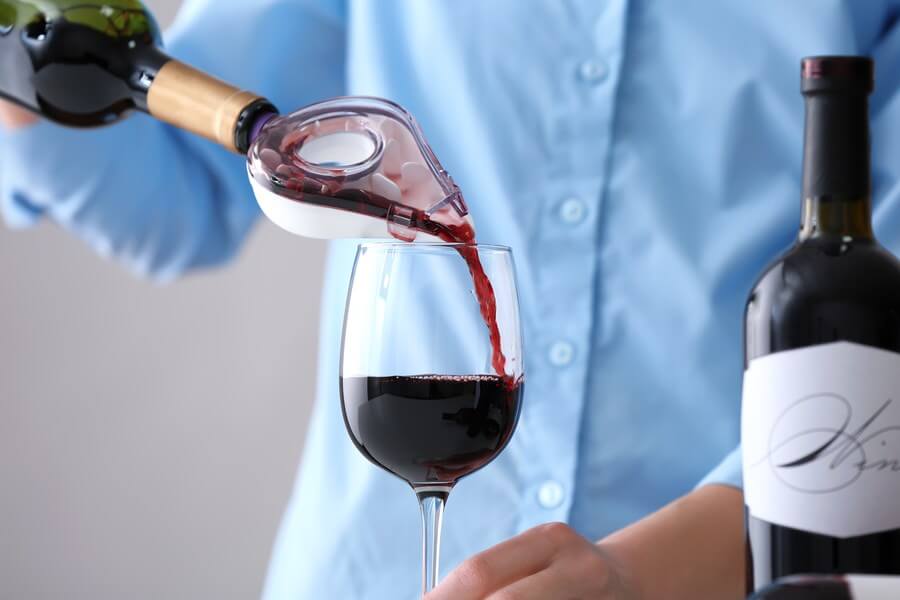‘Let it breathe’ has often been said in relation to wine. However, why does a freshly opened bottle of wine need to breathe, or aerate? Is it crucial? Aerating wine is used to release and enhance the natural flavors and subtle hints within a wine.

Share this article
Aerating Wine
A basic definition of aeration is to introduce air into a subject, wine in this case. Therefore, aerating wine means to introduce air into it, hence the saying ‘let it breathe.’ While this is a simplistic explanation, it does get to the heart of the concept.
All wine is a complexly composed liquid. Wine contains both desired and several volatile undesired compounds. These compounds affect mouth-feel, taste, aroma, and more. The main purpose of aerating wine is to allow for the undesired volatile compounds to leave the liquid. This process results in a wine reaching its full potential. Allowing the drinker to enjoy the full aroma and flavor of the wine.
Introduction Of Air: Oxidation
During portions of the production process and storage, oxygen is the wines arch-nemesis! However, after opening a sealed bottle, oxygen can become the wine’s best friend. If properly aerated, the best flavors, hints, and aromas of a vintage reach their peak.
One of the major components of wine are tannins which give the wine its tangy taste and contribute to mouth-feel. Tannins bring out exquisite tastes when combined with the right food (a topic for another article). However, tannins can develop a very bitter taste within a wine. Oxygen helps in the decomposition of tannins, leading to better tasting wines.
Aeration’s Effect On Wine Composition
Many wineries add sulfites during the production of wine in order to improve the production process. Sulfites, like tannins, can also add a somewhat unpleasant taste to the wine. As well, the naturally occurring sulfides can create an unpleasant smell. Luckily, both of these components are very volatile and the process of aeration forces them to evaporate quickly. Ultimately leaving behind only the desired aromatic components of the wine.
Interested in Aerating your next bottle? Check out these amazing aerators!
Ethanol is another compound found in wine. Most wines have a somewhat regulated ethanol content. However, bad wines can smell like disinfectant when first opened. This is due to an unbalanced ethanol content. Ethanol is also very volatile, by aerating wine, it ‘escapes’ easily. What is left is a delicious, aromatic and flavorful bottle/glass of wine.
There are several choices for faster wine aeration in the form of wine bottle aerators, aerating wine glasses or a wine aerating decanter.
Properly Aerating Wine
There is no uniquely prescribed way that aerating wine should be done. Some wines demand a longer aeration time. Some demand shorter aeration time. Furthermore, there are many wines that don’t require aeration at all. The wines that are in need of aeration are mostly red wines, while most whites don’t need to be aerated.
The simplest thing you can do to aerate your wine is to open it a good amount of time prior to serving.
However, if you are in a hurry, or have impromptu guests, you can use help in aerating. There are several choices for faster wine aeration in the form of wine bottle aerators, aerating wine glasses or a wine aerating decanter.
Wine Bottle Aerators:
A wine bottle aerator is an attachment to a wine bottle that replaces the cork once opened. Allowing only the right amount of air in, and aerating beautifully while pouring; this is the easiest of aeration solutions. Simply replace the cork and go. There are aerators of this variety that come with travel bags and are compact enough to fit in a pocket or purse. This versatility is a great advantage.
Aerating wine glass
It is possible to aerate your wine in the glass. The purpose of swirling wine within a glass is for aeration. Furthermore, wine glasses are specifically designed for particular types of wine to allow this.
An aerating wine glass is a glass that has a special design allowing it to introduce air bubbles into the wine. While pouring the wine in such a glass, it gets mixed and the air works its magic on the wine.
Wine aerating decanter
Decantation is pouring a liquid from one vessel into another. Therefore, to decant wine means to pour it from a bottle into a proper wine decanter. A wine decanter has a dual purpose – easy pouring and aerating the wine.
A wine aerator decanter can be used to quickly aerate wine. It will improve the taste of the wine.
Additionally, use a wine aerator decanter when serving older wines. While decanting the wine, it is easy to follow the residues ensuring the sediment stays in the bottle. Leaving a beautiful, perfect, and untainted product.
Conclusion:
Wine aeration is a personal preference but does have many benefits. It should be recommended because not all wines need to be aerated. Next time you are serving wine to your guests, be prepared, know the type of wine you are serving and enjoy like a true wine connoisseur.